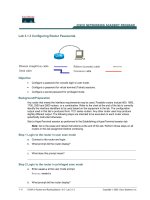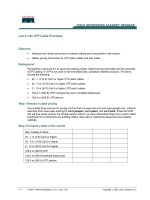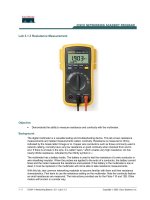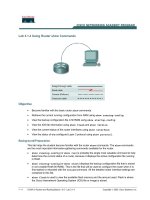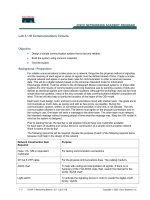Lab 3.1.9d Crossover Cable Construction
Bạn đang xem bản rút gọn của tài liệu. Xem và tải ngay bản đầy đủ của tài liệu tại đây (87.72 KB, 4 trang )
1 - 4 CCNA 1: Networking Basics v 3.0 - Lab 3.1.9d Copyright 2003, Cisco Systems, Inc.
Lab 3.1.9d Crossover Cable Construction
Objective
• Build a Category 5 or Category 5e (CAT 5 or 5e) Unshielded Twisted Pair (UTP) Ethernet
crossover cable to T568-B and T-568-A standards.
• Test the cable for continuity and correct pin-outs, correct wire on the right pin.
Background
This will be a 4-pair "crossover" cable. A crossover cable means that the second and third pairs on
one end of the cable will be reversed on the other end. The pin-outs will be T568-A on one end and
T568-B on the other end. All 8 conductors (wires) should be terminated with RJ-45 modular
connectors.
This patch cable will conform to the structured cabling standards. If the patch cable is used between
hubs or switches, it is considered to be part of the "vertical" cabling. Vertical cabling is also called
backbone cabling. A crossover cable can be used as a backbone cable to connect two or more hubs
or switches in a LAN, or to connect two isolated workstations to create a mini-LAN. This will allow the
connection of two workstations or a server and a workstation without the need for a hub between
them. This can be very helpful for training and testing. To connect more than two workstations, a hub
or a switch will be needed.
Prior to starting the lab, the teacher or lab assistant should have a spool of Cat 5 or Cat 5e UTP
cable, RJ-45 (8-pin) connectors, a RJ-45 crimping tool and an Ethernet / RJ-45 continuity tester
available. Work individually or in teams. The following resources will be required:
• One 0.6 to .9 m (2 to 3 ft) length of Cat 5 cabling per person or team
• Four RJ-45 connectors, two are extra for spares
• RJ-45 crimping tools to attach the RJ-45 connectors to the cable ends
• Ethernet cabling continuity tester which can test crossover type cables, T568-A to T568-B
• Wire cutters
Step 1
Create a crossover cable using the following tables and diagrams. One end of the cable should be
wired to the T568-A standard. The other end should be wired to the T568-B standard. This crosses
the transmit pairs and the receive pairs, the second and third pair, to allow communication to take
place.
Only four wires are used with 10BASE-T or 100BASE-TX Ethernet.
2 - 4 CCNA 1: Networking Basics v 3.0 - Lab 3.1.9d Copyright 2003, Cisco Systems, Inc.
Step 2
Determine the distance between devices, or device and plug, and then add at least 30.48 cm (12 in.)
to it. Standard lengths for this cable are 1.83 m (6 ft) and 3.05 m (10 ft).
Step 3
Cut a piece of stranded UTP cable to the desired length. Use stranded cable for patch cables
because it is more durable when bent repeatedly. Solid wire is fine for cable runs that are punched
down into jacks.
Step 4
Strip 5.08 cm 9 (2in.) of jacket off one end of the cable.
3 - 4 CCNA 1: Networking Basics v 3.0 - Lab 3.1.9d Copyright 2003, Cisco Systems, Inc.
Step 5
Hold the four pairs of twisted cables tightly where the jacket was cut away. Reorganize the cable
pairs into the order of the 568-B wiring standard. Take care to maintain the twists since this provides
noise cancellation.
Step 6
Hold the jacket and cable in one hand. Untwist a short length of the green and blue pairs, and
reorder them to reflect the 568-B wiring color scheme. Untwist and order the rest of the wire pairs
according to the color scheme.
Step 7
Flatten, straighten, and line up the wires. Trim them in a straight line to within 1.25 cm to 1.9 cm (1/2
to ¾ in.) from the edge of the jacket. Be sure not to let go of the jacket and the wires, which are now
in order. Minimize the length of untwisted wires because sections that are too long and near
connectors are a primary source of electrical noise.
Step 8
Place an RJ-45 plug on the end of the cable with the prong on the underside and the orange pair,
green pair on the 586-A end, to the left side of the connector.
Step 9
Gently push the plug onto wires until the copper ends of the wires can be seen through the end of
the plug. Make sure the end of the jacket is inside the plug and all wires are in the correct order. If
the jacket is not inside the plug, the plug will not be properly gripped and will eventually cause
problems. If everything is correct, crimp the plug hard enough to force the contacts through the
insulation on the wires, thus completing the conducting path.
Step 10
Repeat steps 4-8 to terminate the other end of the cable using the 568-A scheme to finish the
crossover cable.
4 - 4 CCNA 1: Networking Basics v 3.0 - Lab 3.1.9d Copyright 2003, Cisco Systems, Inc.
Step 11
Test the finished cable. Have the instructor check it. How is it possible to tell if the cable is
functioning properly?



